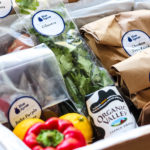Vegan, Healthy, and Organic Food Shopping on a Budget
Whether you are looking to start a new vegan or vegetarian plan, eat organic foods, or simply looking to buy fresh foods and eat healthier in general, one of your main concerns may be rising costs.
Usually one of the top concerns or barriers people cite for not eating organic produce (if they want to), or having fears about embarking on new vegan or vegetarian plans are higher food costs.
Even if you don’t want to follow a vegan or vegetarian diet and simply want to eat a healthier diet with a variety of fresh food options (including fresh produce), you may have concerns about how that will change your spending habits at the grocery store.
So we wondered, are there any helpful tips or tricks to use to save while eating healthier food options? Even if you’re looking to make the shift towards a full vegan lifestyle, can this be done on a budget?
We considered some tips and tricks for saving money at the grocery store if you’re looking to eat healthier foods, fresh produce, or even vegan and organic options.
Eating on a Budget: Healthy Foods and General Trends
Eating fresh and healthy foods, especially if you want to try out new diets (be it gluten-free, vegan, or go organic), can be difficult if you are also trying to work around a budget.
Whether you’re just feeding yourself or you’re feeding a family (or part of a working couple), food costs can be a roadblock for some of us in obtaining healthier sources of protein, fresh produce, and much needed energy.
In communities where poverty levels increase, there’s often a negative correlation with nutritional intake. Unfortunately this can mean stocking up on foods that are inexpensive but have little or no nutritional value, leave you feeling tired or bloated, and over time can even lead to disease and/or obesity trends.
In communities with populations of higher socioeconomic levels, the opposite is often true. With money comes an ability to obtain fresher foods and quality organic food that a lot of us can’t afford, especially when we’re trying to feed a family or manage hectic work schedules around.
But there are some ways we can overcome these trends, and tips and tricks you can use to save on foods that you may not normally buy or consider. Even if you’re thinking about going vegan but scared about the price tags involved, it may be easier than you think to save- or at least not spend more than you are already.
Eating on a Budget: Organic Produce and Foods
When it comes to eating organic foods like fresh produce or organic eggs, there are a few helpful savings hints, and often you may want to ask if you really want the organic option (or if you’d like a combination of mostly organic foods and other supplement add-ons).
With organic produce, the use of coupons really becomes key. If you can locate a store in your area that tends to have the lowest prices for produce in general (and if you do not want to waste time by comparison shopping, you can also try searching online reviews or asking around first with friends and neighbors), and then use coupons, the savings on organic produce can be massive.
The same can be said for other products like organic eggs, which go on sale from time to time, but will often be featured in coupon lists. Grocery stores do this especially if they aren’t selling enough product, and especially because the margins with a product like eggs are so much higher.
Eating on a Budget: Vegan and Vegetarian Diets
One common theme or concern we hear expressed when talking about vegan and vegetarian plans, or thinking about them ourselves, is spending more money.
Sometimes our minds immediately jump to the “vegan” section of the grocery store at upscale chain retail stores, where you can find everything from vegan french ice cream to overpriced tempeh products.
What we don’t often realize is many of the foods we already eat, in fact everything other than meat and dairy, is “accidentally vegan,” in the sense that we are purchasing these goods anyways, and it does not have to come in the form of overpriced nutritional yeast or chia seeds to still be considered a part of the vegan plan.
If you use coupons for produce (which at most grocery stores are always on either the front or back page and readily available), and combine this with healthy sources of grains, whole foods that are in season, and plan to home cook meals in advance, it is definitely possible to eat a vegan or vegetarian diet without breaking the bank.
On top of this, think of all the money you can save by skipping on the sirloin steaks and deli meat sections (my total grocery bills usually add up the quickest from the prepared foods sections, and foods dense in meat tend to take the top spot).
Here are some tips for eating a vegan diet without giving your wallet a workout:
- Stay away from the “Vegan Section”
While it may seem easier and tempting, especially if you’re new to a vegan diet plan, to go straight for the section labelled “vegan,” these foods tend to be extremely overpriced and marketed for consumers without much experience in shopping for vegan or vegetarian products. This is not to say they aren’t good foods, or that you shouldn’t purchase them if desired or if you can afford them, but on average they tend to be heavily marked up. It’s best to try and form a list of foods ahead of time (even if it means researching ones that fit a vegan plan you’d enjoy), and browse for discounts within the store. Also, most of the foods in the vegan section of your local grocery store tend to be pre-packaged and prepared, and making your own meals can save a lot of money, vegan or not.
- Use Coupons and Buy in Bulk
While this is something we all tend to do while shopping for groceries on a budget, it’s particularly important when you’re looking for foods like grains, pasta, and flour. Rather than buying pre-packaged products, buying in bulk quantities can really save you money, and you’ll also have spare ingredients to cook with (can you ever have too much flour on hand when in need?)
The use of coupons to either buy in bulk or to stock up on grains, flour, and fresh produce also seems like a no-brainer, but we often forget to pick up coupon code lists on the way into the market (or the way out for our next trip). It can really add up and save on your bill total, especially for vegetarian and vegan friendly options.
- Compare Stores and Local Markets
Depending on where you live, you should always comparison shop before buying. While it can take some extra time and depends on your schedule, previewing options beforehand can make a world of difference. Often different stores will have savings and deals on the exact same products you would have purchased elsewhere for much more, and it always makes sense to do some hunting before you buy. If you have any Asian markets local to your area, you can also find some of the best vegan options at discount prices and local fresh produce for deep discount prices.
While it may be easier to pick one store and stick to it, if you live in an area with several nearby grocery stores, especially if you are changing your diet and new to the vegan plan or lifestyle, it’s always wise to shop around first and get a sense of where the cheapest produce and grain sources can be found closest to you.
- Understand Grocery Store Tricks
This hint really applies to anyone looking to save on food costs and grocery store runs, but especially if you are trying to save money and work around a special diet, understanding tactics grocery stores use to get you to spend more money can be especially important. The first rule of thumb for any grocery shopper is to never go in hungry, which is a defensive tactic if anything.
But it’s also important to remember that grocery stores tend to pair more expensive items (i.e. creams and dips) next to chips you were already looking for in the first place, always have an overflow of large carts (which makes you forget how much you are buying), and place items throughout the store very carefully to try and maximize sales. So with every trip to the store, take your time to look at both ingredients and prices, to see what works best for both your diet and budget.
Eating on a Budget: The Takeaway
While it is not always easy, it is always possible to save money (or at least not increase your budget) while making healthier food choices.
By cooking meals at home, using coupons and buying in bulk, shopping at local markets with deals, shopping and comparing ahead of time, and preparing foods prior to eating, you can save a great deal and still get the health benefits that come with a balanced diet.
Even if you’re seeking a vegan or vegetarian plan, it’s important to not be scared off by what can seem like a large increase in spending. If you consider the cost per meal (home cooked) after following all of these simple steps, it really adds up to the same prices you’d see at a local chain restaurant or even fast food establishment.
We can all rejoice in knowing that we can eat fresh, whole, and clean foods without having our money go to waste- but rather towards fueling our bodies and health.
Beverly joined MFS with a diverse breadth of experience in writing and digital marketing. Throughout the years of placing recipes on MFS, I’ve noticed an uptick in the number of “subscription boxes” for the cooking/food market. It was then that I decided to also include my own personal review of these subscriptions on MFS.





